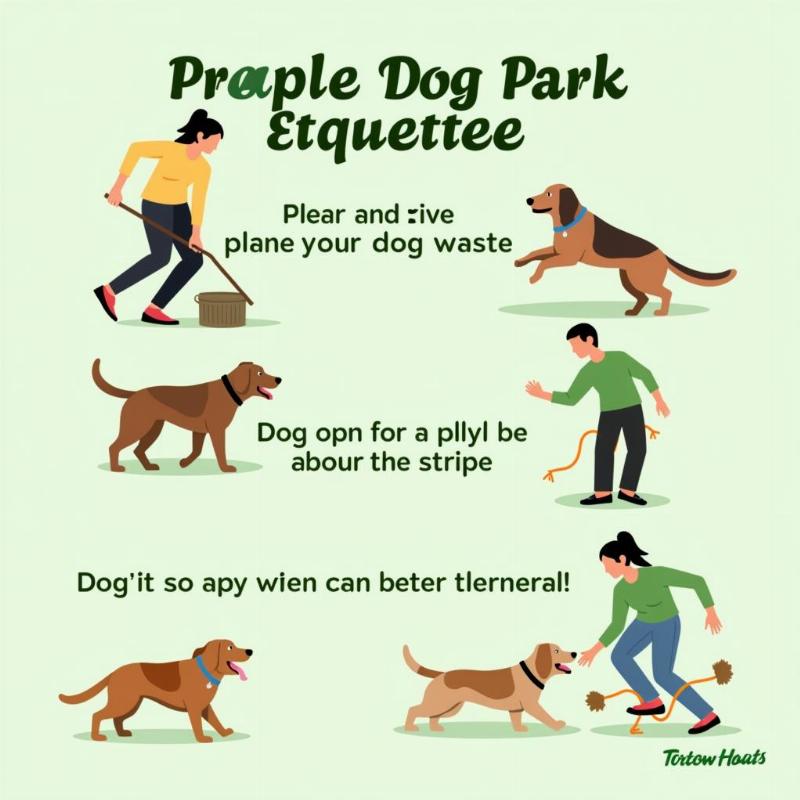Taking your dog, let’s call him AJ, to the dog park can be a fantastic way for him to socialize, exercise, and burn off some energy. However, a successful trip requires preparation and awareness. This guide provides essential information for US dog owners to ensure AJ’s and other dogs’ safety and enjoyment at the dog park.
Preparing AJ for the Dog Park
Before heading to the dog park, ensure AJ is up-to-date on his vaccinations, including rabies, distemper, parvovirus, and kennel cough. This protects him and other dogs from potential diseases. Also, ensure he is adequately protected against parasites like fleas and ticks, which can be easily transmitted in a dog park environment. A well-fitted collar with identification tags and a registered microchip are crucial in case AJ gets separated from you.
Obedience training is another important aspect. A dog who understands basic commands like “come,” “stay,” and “leave it” is easier to control in a stimulating environment like the dog park. This ensures AJ’s safety and prevents unwanted interactions.
Dog Park Etiquette for a Smooth Visit
Once at the dog park, observe AJ’s body language and interactions with other dogs. A relaxed dog will have a loose posture, a wagging tail, and engage in playful bows. Signs of stress or aggression include tucked tails, raised hackles, whale eyes (showing the whites of their eyes), and stiff body language. If AJ displays any of these signs, it’s best to remove him from the situation immediately.
 Dog park etiquette for a smooth visit
Dog park etiquette for a smooth visit
Always supervise AJ closely. Even if he’s generally well-behaved, unexpected situations can arise. Be prepared to intervene if necessary. And, of course, always clean up after your dog. Bringing poop bags and disposing of waste properly keeps the park clean and hygienic for everyone.
Choosing the Right Dog Park for AJ
Not all dog parks are created equal. Some parks have separate areas for small and large dogs, which can be helpful if you have a smaller breed. Consider the park’s amenities, such as water fountains, shade, and seating areas.
Some parks even have agility courses or other features that can add to AJ’s enjoyment. Choosing a park that suits AJ’s size, temperament, and activity level ensures a positive experience. You might even want to visit the park without AJ first to assess the environment and the other dogs present.
Is AJ Ready for the Dog Park? Assessing Your Dog’s Temperament
Before bringing AJ to the dog park, honestly assess his temperament. Is he friendly towards other dogs? Does he get easily overwhelmed or stressed in new environments? If AJ has shown signs of aggression or fear-based reactivity towards other dogs, the dog park might not be the best environment for him. Consider consulting with a professional dog trainer or behaviorist to address these issues before introducing him to a dog park setting.
Conclusion: Making the Most of AJ’s Dog Park Adventures
Taking AJ to the dog park can be a rewarding experience for both of you. With proper preparation, awareness of dog park etiquette, and careful selection of the right park, you can ensure a safe and enjoyable outing. Remember to observe AJ’s behavior, be prepared to intervene if needed, and always clean up after him. By following these guidelines, you can help AJ enjoy the social interaction, exercise, and mental stimulation that the dog park has to offer.
FAQ:
- What should I do if my dog gets into a fight at the dog park? Separate the dogs calmly and quickly. Do not put your hands between them. Check both dogs for injuries.
- What if my dog is afraid of other dogs at the park? Remove your dog from the situation immediately. Consider working with a trainer to build his confidence around other dogs.
- Can I bring treats to the dog park? It’s generally best to avoid treats, as they can cause resource guarding and conflict between dogs.
- What should I do if my dog runs away at the dog park? Call his name calmly and try to lure him back with a favorite toy. Inform other park visitors that your dog is lost.
- How often should I take my dog to the dog park? The frequency depends on your dog’s individual needs and preferences. Start with short visits and gradually increase the duration as he becomes more comfortable.
- What are the signs of an overstimulated dog at the dog park? Signs of an overstimulated dog can include excessive barking, jumping, nipping, and frantic pacing.
- Can puppies go to the dog park? Puppies can go to the dog park once they have completed their initial vaccinations, but it’s essential to choose a park with a designated puppy area.
Related Articles on Beautdogs.us
Beautdogs.us is your leading resource for comprehensive dog care information, breed-specific advice, and a wide array of products tailored for the US dog owner. Whether you’re a seasoned dog owner or just starting your journey, Beautdogs.us empowers you with expert knowledge and connects you with relevant products and services. From dog-friendly hotels to stylish apparel, discover everything you need to enhance your bond with your canine companion. Contact us for personalized advice and support: Email: [email protected], Phone: +1 501-555-7529. Visit Beautdogs.us today!